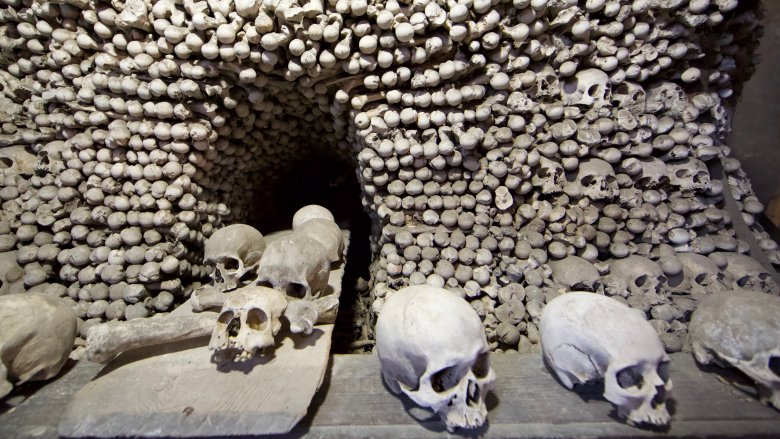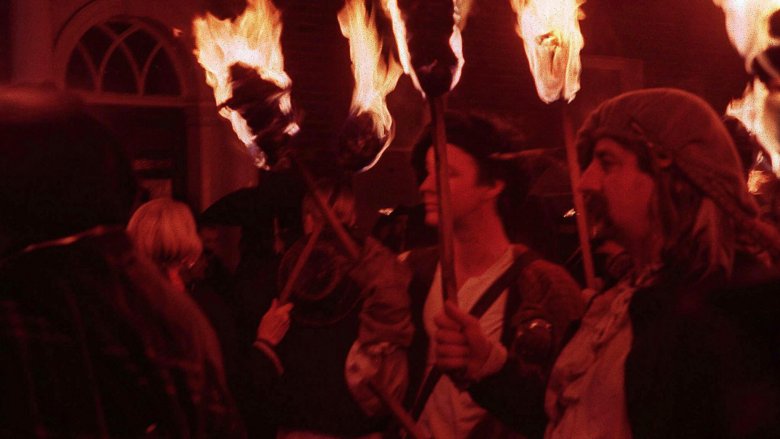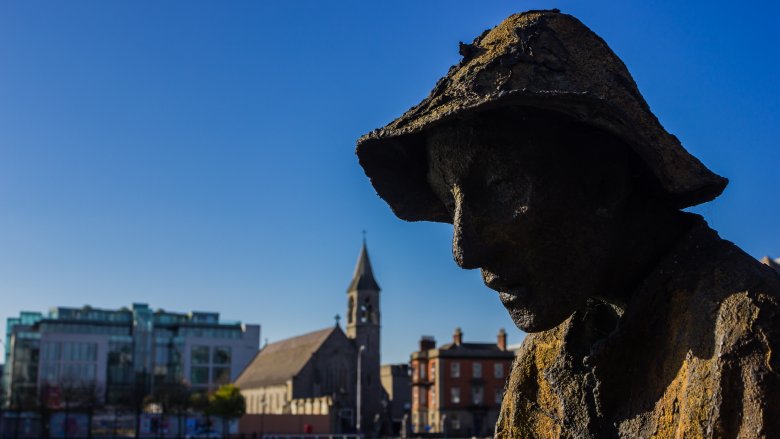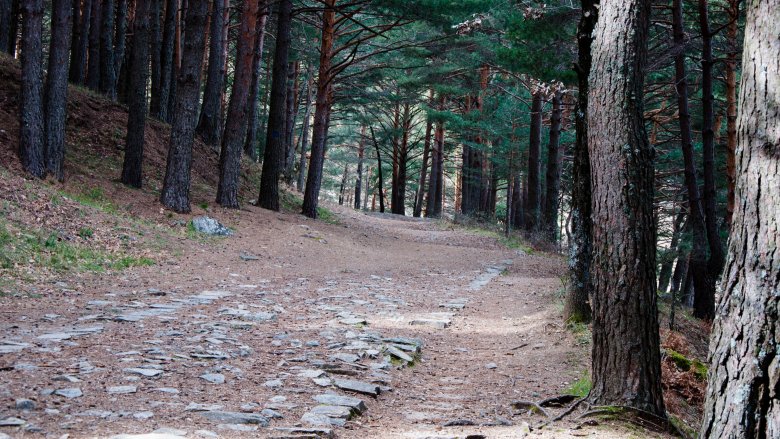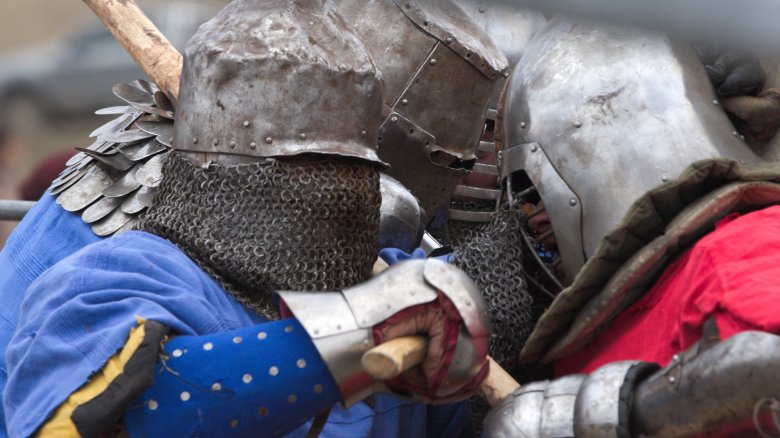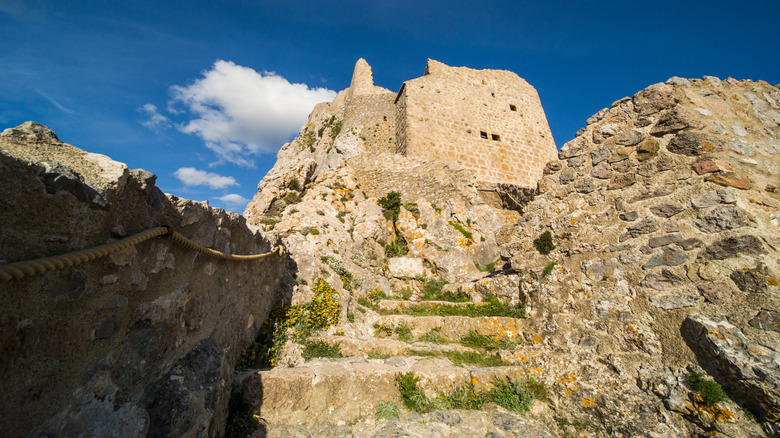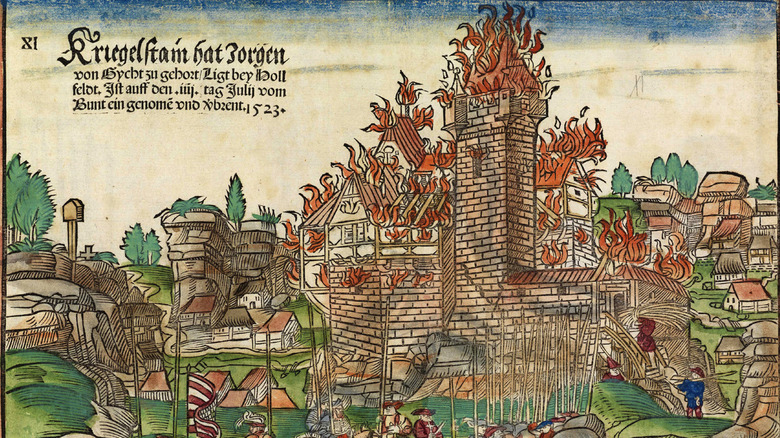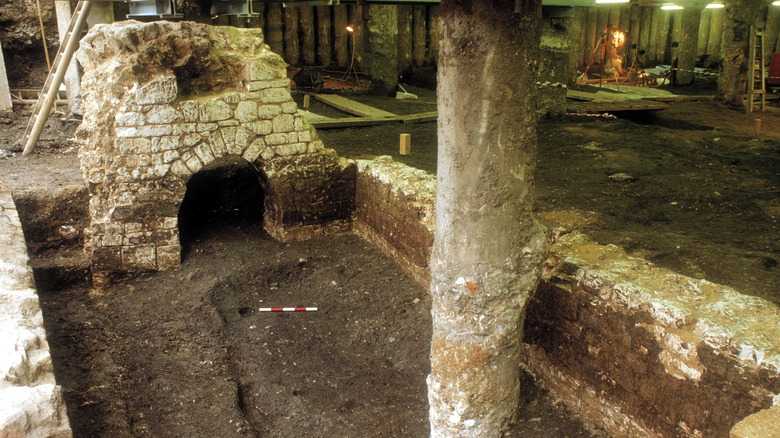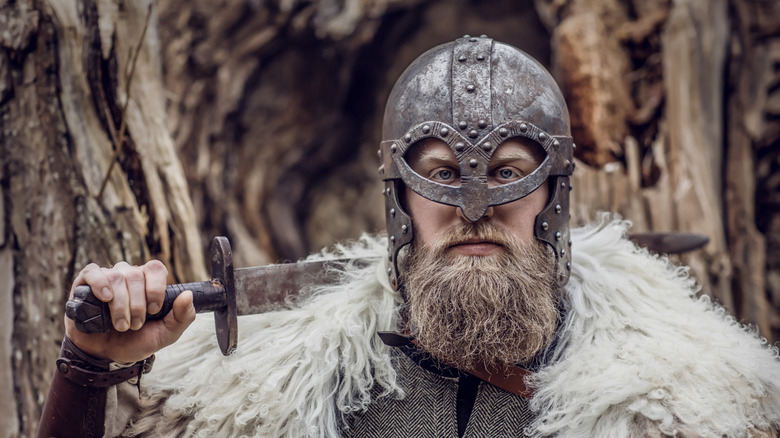Why You'd Never Survive Life During The Middle Ages
If you believe Hollywood, life during the Middle Ages was romantic and glamorous, full of noble knights on noble steeds, beautiful ladies with pointy hats, chivalry, honor, and occasional dragons. It's enough to make you want to hop in a T.A.R.D.I.S. and travel back through time. And you might be shocked to hear that Hollywood has it all backward. "No!" you shout, "Not Hollywood, bastion of honesty and purveyor of historical truths! Say it ain't so." Well, it's so.
The Middle Ages of Europe were really nothing like the Middle Ages of Hollywood. For almost everyone, life was difficult, dirty, and dangerous. People died young, and they often died from things that almost never kill people in the modern world. So if you did have a chance to time travel back to those days of olde you might be surprised by how long you'd actually last there, which is not very long. Here's a short list of reasons why you — and to be honest, everyone else — wouldn't survive long in the Middle Ages.
You might not make it past childhood in the Middle Ages
Grief is awful no matter what form it takes, but in the West we are less likely to experience the worst version of it. In America, infant mortality is only around .54 percent, and it gets better once kids pass infancy. Mortality for children between the ages of 1 and 4 is around .02 percent, and for kids aged 5 to 14 it's around .01 percent.
Now compare that to childhood mortality in the Middle Ages. According to Representing Childhood, exact numbers are impossible to come by, but estimates place the medieval infant mortality at around 25%. That means one out of every four babies born during that time period would die within the first year of life. The odds went up a bit for children who made it to toddlerhood — kids between the ages of 1 and 4 had a mortality rate of around 12.5%. If they made it to 5 then they were really cruising — the mortality rate for kids between the ages of 5 and 9 was only about 6%. Still, that was worse than the mortality rate for infants in modern America, but hey, at least medieval kids got to play with swords and drink alcohol and stuff without any of those oppressive child safety laws. Small price to pay.
Chances are you'd be a peasant, and peasants in the Middle Ages died young
So if you somehow did manage to T.A.R.D.I.S. your way into medieval society, you're probably going to stick out like a purple unicorn in a herd of white horses, what with your iWatch and your blue jeans. So you're going to have to make yourself inconspicuous pretty quickly, and you're not going to do that by putting on a velvet robe and pretending to be the queen. No, your best chance is to blend in with the peasant population, where no one is likely to notice you.
Peasants in medieval Europe comprised around 90% of the population, so what's one more peasant, really? The problem with becoming a peasant, though, is that the life of a peasant sucked. According to Western Reserve Public Media, peasants wore the same danged rough, itchy wool outfit every day, ate bread, porridge, and vegetables, and if they were lucky, they got a little bit of meat occasionally. And also when the weather was harsh, they died. Peasants would starve when the weather was too wet and they would starve when the weather was too dry because when the crops failed so did they. The average life expectancy for a peasant was between 30 to 40 years, depending on the time frame, as per History Extra.
If the weather didn't kill you, the Black Death would
Nobody gets the Black Death anymore, except for 20,000 people between 2000 and 2009, including 56 people in the United States (but that's another story). But if we just pretend we don't know that and if we avoid chipmunks like the plague because chipmunks are freaking plague-carrying harbingers of death, then we mostly don't have to worry. But travel back in time to, say, 1340s Europe, and your chances of surviving are somewhere between seven in 10 and two in five.
Estimates suggest the Black Death killed as much as 60% of the entire population of Europe. To give yourself an idea of just the sort of impact this might have had, the next time you're at work you can tick off three out of every five people you see and pretend they're deceased and then try to figure out how you and your colleagues would manage without them.
Here's the crazy part, though. With your colleagues gone, you're suddenly in a position to go, "Hey boss, it looks like you need a new middle management team!" That's what happened in the Middle Ages, too. After half the world died, it kind of changed the balance of power. Suddenly, peasants could ask for pay raises and improvements in working conditions and life actually got better for them. Probably not worth losing three-fifths of everyone you ever loved, but hey, money is the great softener of blows.
If the Black Death didn't kill you, childbirth would
Women had it especially hard during the Middle Ages. They were generally regarded as morally weak, and they weren't allowed to do things that modern women take for granted, like getting a job, deciding who to marry, and having opinions about things. There were some powerful women, granted, but they were pretty uncommon.
The worst part about being a woman, though, was that you were expected to procreate or else become a nun. And frankly, becoming a nun sounds pretty tempting compared to the dangers of procreation, which would kill like one out of every three women. Compare that to today's maternal mortality rate of one out of every .028% and no one's going to blame you if you decide to take the T.A.R.D.I.S. back to civilization once your nine months are up.
According to the Raven Report, childbirth in the Middle Ages and the Tudor period were so dangerous that royal women were encouraged to write out a last will and testament well in advance of giving birth. Just imagine working that in somewhere between decorating the nursery and setting up your kid's college savings account.
In the Middle Ages you could be killed for your religion, or lack thereof
Everyone in medieval Europe was a good Catholic, except for those who weren't, and they either had to pretend to be or else be prepared to die for their beliefs. The concept of religious freedom was most definitely Not A Thing.
During the 11th and 12th centuries, people started thinking critically about the Catholic Church, and one of the things that certain critical thinkers disliked about the Catholic Church was its wealth and power. If history has taught us anything it's that people who have wealth and power don't especially love when people who don't have wealth and power start criticizing them for having wealth and power. But these were extra dangerous times because the Church was so wealthy and so powerful that it could pretty much just snuff out its critics, and it could do that in the name of God, because, you know, it was the Church and therefore everything it did was ordained.
No one is really sure how many people were burned during that time period, but we do know it was sometimes done in groups of 200 or more. And it didn't end for a long time, either — Queen Mary burned 300 Protestants in the 1550s. So visit medieval Europe, sure, but remember, pope jokes are out.
Famine wasn't just something you could pretend wasn't happening to other humans
In the modern West, hunger doesn't have anything to do with the availability of food — it's a symptom of poverty, not the weather. When we have crop failure in here, we get food from other places if we can afford it. Famine as we understand it is something that happens in the developing world, where we can mostly just ignore it and complain about our first world problems instead, like how hard it is to get good cell phone service in rural America. In the Middle Ages, most people did not have the luxury of just getting food from somewhere else. And also, there was no cell phone service anywhere, so, hard times.
When famine struck it was epic and deadly. From the summer of 1314 through most of 1316, England was plagued by uncharacteristically huge quantities of rain. And if you've ever been to the U.K., you know that "uncharacteristically huge quantities of rain" is just seriously a ton of rain because typical rainfall is already pretty heavy by most standards. Anyway, it rained and rained, and crops rotted in the fields, farm animals drowned in floods, all the stored food got eaten and then people started to starve. By the end of the famine, roughly 5% of England's population was dead, which isn't Black Plague terrible, but it's nowhere near Whole-Foods-just-ran-out-of-kale terrible, either.
Forget that summer holiday backpacking around Europe in the Middle Ages
If you wanted to travel in the Middle Ages, the local monastery offered a clean, safe place to sleep, but what if there was no local monastery? Well, you could stop at an inn. Sure, the beds were made of straw and you might have to share yours with one or two other travelers, and there were rats and so many fleas that it was sort of similar to donating a pint at the local blood bank, only itchier — but it was a mostly safe place to spend the night.
Depending on where you were going and how many villages you might encounter on the way, though, you weren't always going to have the option of staying in an inn. And that might mean sleeping out in the open, which "Travel and Trade in the Middle Ages" says was a terrible, terrible idea. There were always people lurking on the roads after dark, ready to murder you for your pocket change, and wild animals were a problem, too. People embarking on pilgrimages during the Middle Ages often traveled in groups for safety, and wealthy people would sometimes just pay someone to go on pilgrimage for them, which kind of seems to be defeating the purpose but whatever.
So anyway, if part of your time travel fantasy involves backpacking across medieval Europe, forget it. Though you could always just pay someone to do it for you.
Wars in the Middle Ages were even stupider than they are today
Modern wars are always over sensible things, like which country has the bigger missile and whose soccer team is more awesome. But in the Middle Ages, wars were fought over really stupid things, like which unqualified rich person was going to end up sitting on the throne.
So that's between Rich Person One and Rich Person Two, except that it wasn't — if you were male and you happened to reside in the kingdom of one of those two rich people, you'd be compelled to go fight in his stupid war. According to Finer Times, though, it wasn't all that bad — if you didn't die within the first 40 days, you could go back home. That's because it was bad business to draft all the peasants into service at the same time. With no one around to take care of the farms, the kingdom would lose money and then it wouldn't be able to afford the stupid war.
Noblemen died in war, too — before 1550, roughly 30% of them could expect to perish in some battle or another. As for the peasants, well, no one really knows. Peasant deaths were considered so inconsequential that no one ever counted them. And defeat often meant systematic slaughter of all the leftover common people. It definitely wasn't a good time to be a soldier or a peasant.
There were way, way more capital crimes in the Middle Ages than there are today
In the U.K. today, there are no capital crimes because Britain abolished the death penalty in 1965. But prior to that, Britain was big on executing people. During the Middle Ages, there were 50 capital crimes on the books, which included not just treason and various forms of murder but lesser things like poaching, robbery, and forgery.
This is one of those rare instances where you'd actually be better off in the Middle Ages than you would be a little later down the road of history, though. Sure, there are no capital crimes in the U.K. today but by the 1600s the number of crimes you could be officially executed for rose to around 200, and included things like petty theft, "damaging Westminster Bridge," and cutting down a sapling. So basically, if you flew your T.A.R.D.I.S. into Westminster Bridge or a forest with a lot of young trees in it, you could kiss your modern time-traveling butt goodbye. Although, History Extra says the "Bloody Code" of that time period actually resulted in fewer executions, probably because juries were reluctant to sentence people to death for minor offenses.
Just in case, though, you should keep your T.A.R.D.I.S. out of the Middle Ages and also out of the 1600s, just to be on the safe side.
Your food might actually kill you in the Middle Ages
Medieval people were often smelly and illiterate, but they weren't stupid. Everything you've heard about how people in the Middle Ages covered the taste of rotten meat with heavy spices isn't the truth — spices were expensive, and anyone who could afford them could probably also afford to throw out all that rotten meat.
For the most part, people knew how to preserve food. They salted, smoked, dried, and pickled it and there doesn't seem to have been a rash of people dying because they were eating bad meat.
There were other dangers lurking in the food, though. If you were rich, you probably owned a lovely set of fancy glazed dishes, which were full of lead and other heavy metals like mercury. According to Smithsonian, when you filled your plates and bowls up with salty or acidic foods, the glaze would start to break down and those metals would leach into your food. So members of the upper class were slowly poisoning themselves as they dined on luxury dishware.
Meanwhile, bakers sometimes made bread from rye infected with a fungus called Claviceps purpurea, and that could cause an outbreak of an illness that modern medicine knows as ergotism. The infection caused hallucinations, convulsions, a burning sensation in the limbs, and sometimes even blackened body parts that would literally just fall off. When you're traveling back in time, take some trail mix and beef jerky along. You can never be too careful.
If you survived an illness in the Middle Ages, it was probably in spite of your doctor
If you got sick during the Middle Ages, just forget it. There were no antibiotics, no appendectomies, no chemotherapy, and physicians didn't wash their hands in between patients. The things doctors did know about medicine were mostly wrong and almost always totally useless from a medical perspective. A sick person might be diagnosed with the help of an astrological chart, and treatment might include bloodletting, purging, or trepanning, which was the practice of drilling a hole in the skull to relieve pressure in the brain.
Shockingly, these treatments not only rarely worked but sometimes could even hasten a patient's death. Still, the practice of bloodletting persisted for a long time. In fact there's still debate on whether George Washington was killed by strep throat or by the aggressive bloodletting doctors used to treat his condition.
Your best bet, then, is to avoid calling the doctor when you develop a sore throat and fever during your medieval vacation. Or maybe just don't go to the Middle Ages, okay?
And then there was ye good olde fashioned violence
If you escape all those other dangers, you're still left with one very harsh truth: The Middle Ages was just a much more violent time. According to History Extra, murder in medieval England was around 10 times more common than it is today. That sounds really bad until you consider that the murder rate in America is like 4.7 times higher than it is in the U.K., but let's just try to pretend like there's a huge difference between 10 and 4.7.
Still, even with terrifying maternal mortality rates, life expectancy for women in the Middle Ages was considerably better than it was for men — according to Purple Motes, on average a woman could expect to live about 9.4 years longer than her male counterparts, and that was mostly because of violence between men. In fact roughly 46% of all deaths in men ages 15 and above were caused by violence, so yes, as a dude living in medieval England you had a roughly 1 in 2 chance of meeting a bloody end.
The Black Death wasn't the only plague going around
The Black Death gets a lot of press and with good reason, but it was far from the only killer bug haunting medieval immune systems. Smallpox appears to have affected people as far back as ancient Egypt, judging from pox-like blemishes visible on some mummies, and written descriptions matching the disease appear in records from premodern China and India.
While vaccines have now eradicated it from the wild, smallpox was an absolute horror before it was effectively controlled, killing, at a very rough estimate, 30% of the people who contracted it over its long reign. Infection occurred from close contact with a sick or infected person, and the first stage of the disease manifested as a severe bout of flu-like symptoms as the virus replicated within the immune tissues. A few days later, the telltale rash appeared, which could be barely noticeable or so severe the lesions ran together in large patches of inflammation. Children were especially likely to die if infected, and survivors sometimes bore severe, disfiguring scars.
Smallpox and its sister illness, the plague responsible for the Black Death, affected their survivors' immune systems for generations. One positive that came from the disease is a gene that confers natural immunity to HIV infection occurs in some Europeans, making a lucky few unable to catch the newer virus. The original mutation seems to have been an adaptation that helped people resist smallpox, plague, hepatitis, or perhaps even a combination of these diseases.
Dysentery was a common risk
One of the most serious threats to human life in periods and places without effective sanitation is the runny mainstay of recess chants: diarrhea. The more severe dysentery, familiar as a threat to generations of frustrated, mournful "Oregon Trail" players, is defined by the World Health Organization as diarrhea severe enough to contain visible blood. Causes include viruses, bacteria, or parasites. Even in the modern world, diarrhea kills nearly a half-million children annually, along with any number of vulnerable, immunocompromised, or simply unlucky adults.
The most common cause of death for people at risk from severe diarrhea is simply dehydration, with the body's fluid loss leaving it without enough internal water to complete its basic functions. Now, unfortunately, the severity of diarrhea can help it spread through the unappetizingly-named fecal-oral route. People without sanitation including sanitary toilets and clean water for hand washing can contaminate food or water supplies with trace amounts of infected waste, spreading the disease further.
In the pre-germ theory, pre-flush toilet Middle Ages, diarrheal disease could and did lay low even the creme de la creme of medieval society. King John of England was a particularly famous victim. And so was King Edward I of England. And so was King Henry V of England. All three were traveling with armies when they fell ill, and all three, despite being king, could not access clean enough water or food to escape infection and death.
Minor infections could kill in an era before antibiotics
Richard the Lionheart, King of England, Duke of Aquitaine, and holder of a passel of other titles, survived war, crusade, and captivity only to die at 41 when an enemy crossbowman hit him with a lucky shot. The bolt didn't take Richard down by piercing his heart or cracking his skull, but by carrying some bacteria into an otherwise non-threatening shoulder wound. A few days later, the strong and vigorous king died, stinking and feverish, in his mother's arms.
Before antibiotics and modern hygiene, bacterial infections could quickly become fatal. One potential result was gangrene, an extremely grim condition in which limited blood supply to bodily tissues causes them to die and begin the decay process while still attached to the rest of the body, potentially flooding the system with bacteria growing unchecked in the dead flesh. Even today, removal of the affected tissue is part of the standard of care.
Sepsis may also result from an untreated infection. This dangerous condition arises when the immune response to a system is so intense that it begins to damage the body itself, leading to pain, confusion, and possible coma. Even today, sepsis is a medical emergency with a high mortality rate even in well-equipped medical settings.
No weather warnings
Even with modern weather tracking and warning technology, extreme weather can be dangerous — more than 120 Americans die in floods each year. With no warning system in place beyond looking at the sky and older people feeling the pressure change in their joints, premodern people were much more vulnerable to unexpected weather.
The low-lying territories that make up the modern Netherlands were subject to some harrowing floods during the medieval period. On December 14, 1287, a storm surge struck when the tide was already high, smashing the Dutch and German coast so badly that formerly inland cities became ports and lakes became bays of the North Sea. (Formerly inland Amsterdam was one of the beneficiaries of the retooled coastline). This flood may have killed 50,000 people in the most severely affected areas, with deaths occurring even in eastern England. Similar floods in 1953, though devastating, killed "only" slightly over 2,000 people, a reduced death toll made possible in part by evacuations ordered by authorities with forecasting infrastructure.
A second coast-altering flood hit in 1421 killing an estimated 10,000 people and flooding some reclaimed land that the Dutch simply gave up on. Even today, some of the land inundated in 1421 remains underwater.
Your home might be targeted for a Crusade
Not following the locally favored religion wasn't a solid long-term survival strategy, but even conformity wasn't necessarily safe. If you were living near people with "strange" religious beliefs or in a territory a Christian ruler coveted, you could find yourself the target of a crusade.
The most famous crusades are the long series of wars launched by Christian princes of Europe, at the Pope's bidding, to capture the Holy Land and enough surrounding territory to protect it. These led to 200ish years of intermittent bloodbaths across the Levant, Asia Minor, Egypt, and Cyprus, but these classic crusades weren't the only ones. The tribal people around the Baltic Sea were late to Christianize (by their neighbors' standards), leading to another theater of invasion and forced conversion in Europe's north. The Muslim states in Southern Iberia were rolled up by stronger Christian kingdoms, with the final Muslim capital, Granada, falling in the famous year of 1492.
Internal crusades could even be launched within Christian kingdoms. The Cathars or Albigensians of Southern France practiced a "heretical" form of egalitarian Christianity, which gave the French crown the perfect excuse to gin up an army and invade the Southern lands it wanted to control more tightly. The Cathars and their neighbors were ground down over 20 years of warfare, but they did get one treat. The chief crusader general, Simon de Montfort, was squashed by a lucky shot from a catapult.
War was dangerous even if you weren't fighting
If you don't quite have enough men to set up for a long siege or occupation of a territory, don't worry: You can still cause untold destruction and misery. The chevauchee was a particularly savage iteration of a scorched-earth strategy in which a relatively small force went berzerk over a swathe of countryside burning and killing as they went. The carnage was the whole purpose of the chevauchee. Not only were ruined villages and farms unable to contribute anything to their lords' war efforts but the common people would be demoralized in the face of any enemy their overlords were unable to effectively resist. Local leaders would then have an excuse to defect, which was rare but possible.
The chevauchee is especially associated with English forces during the first phases of the Hundred Years War when Edward III and his lieutenants cut bloody zigzags across France. Instead of major battles, the English army wore down France with repeated raids. In the very long term, this strategy didn't work, as France remains an independent country to this day, but the savagery served as a basic tool of the war for decades.
You could get caught up in a siege
Faced with a castle or walled city in their path, an invading army would frequently attempt to capture it by siege. If you have the men, the supplies, and the time, you can simply surround the city, burn the surrounding fields if you like, and wait for hunger and thirst to weaken the defenders until they surrender. If you're in more of a hurry, you can hurl things over the walls with catapults, try to bang down the gate with a battering ram, or build armored siege towers to allow your men to go up and over the wall and drop down inside to wreak havoc.
Those inside a besieged fortification usually had their own weapons and might even send out raiding parties to harass the enemy army. Generally, medieval sieges conducted under the veil of chivalric manners involved an early offer to the city to surrender without ruin. If they refused, they could expect no mercy if and when the hostile force eventually gained access, with looting, violence, arson, and other atrocities almost a given. This not only was considered the "reward" for soldiers on the winning side but also served the strategic purpose of making the commander's and army's reputation more frightening, in hopes that the next city would save itself through quick capitulation.
60 of the most powerful men in central Europe died in a latrine accident
In the summer of 1184, two major landholders within the Holy Roman Empire were squabbling, as was frequently the case, and to attempt to tamp down on the fuss, the emperor's son called an informal gathering in the city of Erfurt. Dozens of princes and officials from various parts of the Empire crowded into the church at Erfurt on the first day of the conference, July 26. With little warning, the floor gave way — bad enough, but unfortunately, the room in which the men had gathered was right above the area where the church's latrine drained.
Medieval records are seldom very clear, which on this occasion may be a blessing, but between 60 and 100 imperial bigwigs died, either crushed under debris or drowned in the appalling sludge below. The emperor's heir and the Archbishop of Cologne only survived by hanging onto window rails. Whether the original beef persisted after the crisis is not recorded. The point here is that if a creaky floor and an ill-placed cesspit can combine to create an event known to history as the "Erfurt Latrine Disaster," resulting in the deaths of dozens of rich, powerful men, the everyday person had no chance in a low-to-no building code world.
If someone who outranked you wanted to do something dangerous, you had to go along
If the king has a bad idea or even seems like he's ready to go along with a bad idea, it's too bad for you and your common sense if you're one of his hangers-on. In the summer of 1392, Charles VI of France had suffered either a psychotic episode or something that sounded like one while patrolling with his men. He killed several men (history does not report how many because they were not kings) before he could be restrained, but by the following January Charles had recovered enough to be invited to parties again.
Unfortunately, Charles decided to go to this particular wedding in costume as a wild man, tied to five other men in costumes made of cloth and pitch. To his credit, the king had ordered that no one was to approach them with a torch, but that very thing happened in the dark ballroom. The costumes ignited in a fiery whoosh, and the king was only saved when the quick-thinking Duchess of Berry protected him from the flames by covering him with the long train of her dress. Two of the costumed men died that night, and two more followed them in the coming days. The event became known as the Ball of the Burning Men, coming to symbolize a certain kind of reckless optimism that pops up in rich young men.
Sometimes the Mongols show up
There are invaders, and then there are natural disasters in human form. In 1206, Genghis Khan united the Mongols behind him and began to thrash every country within reach, which given the Mongols' skill on horseback was a fairly far reach indeed. By his death 21 years later the Mongols had rolled across China, gobbled Korea, battered Persia, and taken a victory lap around the Caspian Sea. Genghis's son Ogedei took the war to Europe in 1237, capturing Kyiv, Krakow, and Budapest and almost reaching Vienna. Fortunately for whatever cities were next on his list, Ogedei's death in 1241 distracted his heirs from most of Europe, though they would occupy much of Russia for generations more.
Armed with powerful bows and a near-endless supply of strong little horses to ride into battle, the Mongols were a terrifying invasion force. Defiant cities might be sacked so severely that even irrigation systems were destroyed, and the few people left alive after a Mongol conquest were sent forward to report what horrors they had seen. They also used human shields in their initial advances on some cities and took severed ears as trophies. Remember also that the Mongols were very much a new kid: Their victims did not even initially know to fear them, though they soon learned.
...or Vikings
"Viking" is not the name of an ethnic group: It's a job title. Viking is an activity, and unfortunately for a number of people whose homes were accessible from the seas and rivers of Europe during the High Middle Ages, that activity was violent pillage. From about 800 to 1100 CE, boats full of northerners would arrive over the horizon, disgorging their human cargo to load up on movable wealth and people to enslave, killing any who interfered, before leaving ruined cities and monasteries behind them.
The Viking Age unofficially began with the slaughter and sack of the British monastery at Lindisfarne; the failure of the Christian God to intervene may have inspired the Vikings to continue attacking the followers of this powerless deity. Over the following centuries the Vikings traded with the Byzantines (and worked as Imperial guards), founded Dublin, and reached the edge of North America, first among Europeans. By 1066, the Northern kingdoms were Christianizing, changing the moral calculus of Viking raids. That year, Harald Hardrada, the king of Norway was killed at the Battle of Stamford Bridge by the army that would soon lose the Battle of Hastings. (There is no loser's bracket in medieval warfare, sadly.) This wasn't the end of the Viking threat, but in the decades that followed the raids petered out.
Winter was rough
By the mid-1300s CE, the warm conditions that had dominated most of the Middle Ages in Europe were giving way to the relative chill of the "Little Ice Age." Florence was covered in snow for all of February 1352, and in the winter of 1363-64, the Rhine froze solid for weeks, as did the lagoon around Venice. Medieval people prepared for the cold, agriculturally unproductive months by killing animals to preserve and sowing winter crops that would, hopefully, pop up with the first green shoots of the spring.
Medieval peasants shivered in drafty homes: Glass windows were too expensive, so often the openings were covered with paper. Fires, sometimes in portable braziers, helped, but of course, open flames and smoke carry their own risks. They also stayed dressed in as many layers as they could stand and/or afford, indoors or out, but even this was sometimes not enough. In harsh winters, people might freeze, starve, or succumb to the combined effects of cold and hunger. Additionally, heavy snowfalls might occasionally collapse the roof of a modest home, burying the inhabitants under snow and debris.
So sure, T.A.R.D.I.S. your way back to the Middle Ages and take in the sights, but you might want to avoid actually getting out and having a look around. If the Middle Ages were lethal for the people who were born and raised there, a modern person wouldn't really have much hope for survival at all.



